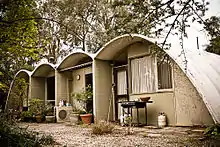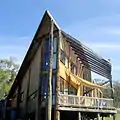Kevin Borland
Kevin Borland (28 October 1926, in Melbourne, Victoria, Australia – 2000) was an Australian post-war Architect.[1] Over his career his works evolved from an International Modernist stance into a Regionalist aesthetic for which he became most recognized. Many of his significant works were composed of raw materials and considered ‘Brutalist’ typifying Borland’s renowned motto ‘architecture is not for the faint-hearted’. Borland died in 2000 leaving a legacy of work throughout Victoria, New South Wales and Tasmania.
Kevin Borland | |
|---|---|
| Born | 28 October 1926 Melbourne, Australia |
| Died | 2000 |
| Nationality | Australian |
| Occupation | Architect |
| Notable work | Preshil (Junior Campus), Harold Holt Memorial Swimming Centre |
| Style | Brutalist architecture |
| Spouse(s) | Margaret Aitken, 1954–1979 (her death) Huan Chen Tan 1986–2000 (his death) |
| Children | 6 daughters including Polly Borland, 1 son |
| Parent | Kevin Borland |
| Awards | RAIA |
Formative years
From 1938 to 1941 Borland attended University High School and at age 15 was offered a job as office hand at the studio of Best Overend, a pioneer of modernist architecture in Melbourne. That same year he began part-time tuition at the Melbourne Technical College studying Building Construction and Geometrical Drawing. In 1944 Borland attended first year of a Bachelor of Architecture degree at the University of Melbourne before withdrawing to join the Royal Australian Naval Reserve, serving in WWII from July 1945 to January 1947. Upon return Borland recommenced studies under the newly appointed tutors Roy Grounds and Robin Boyd. During these years Borland was an active member of the University branch of the CPA (Communist Party Australia) and the Melbourne University Labor Club. Borland’s belief in an idealistic society of economic, educative and social equality was intensified by his experiences at war and remained prevalent throughout his career and life.[2] Borland received the Illuminating Engineers Society Student Award for Light in Architecture in 1949 and in 1950 graduated with second class honours in Town Planning.
Career
During 1951 and 1952, Borland worked for ‘the Age’ Royal Victorian Institute of Architects Small Homes Service under former tutors Robin Boyd and Neil Clerehan.[3] The service aimed to supply the general public with modest affordable architect-designed homes. Through the service Borland obtained his first two major domestic commissions. The second of these (and first completed) was the Rice House (1952–53), which used an innovative method of chicken wire reinforced concrete shells in a lightweight form of slender vaulting roofs. The design reflects Borland’s improvisation of medium, and a deep sense of Humanism, which he carried on throughout his career.[4]
Borland’s first public building, in collaboration with John and Phyllis Murphy, Peter McIntyre and engineering consultant Bill Irwin - the Olympic Swimming Stadium in Melbourne (1952–56) - precedes many collaborative projects for large institutional buildings. The scheme’s expression of primary structure reveals an idea of the interdependency of all building components.
1957 saw the beginning of the Borland & Trewenack practice which received recognition for works such as Mcarthy House, Stein House (1959), and Preshil Hall (1962). After 8 years Borland established an independent practice, and over the next decade became widely recognized, receiving numerous accolades for both residential and public commissions.
Awards
- RAIA Victorian Architectural Medal for Outstanding Building, 1972. School Hall at Preshil (Junior Campus), Kew (1962).
- RAIA Victorian Chapter, Citation in the Public Buildings category, 1969. Harold Holt Memorial Swimming Centre, Glen Iris (1968–69).
- RAIA Victorian Chapter House of the Year, 1972. Paton House, Portsea (1970).
- RAIA Victorian Chapter, Bronze Medal in category ‘House of the Year’, 1974. Nichols House, Eltham (1973).
- RAIA Victorian Chapter, Citation, 1974. Crossman Flats, Launching Place (1973).
- RAIA Victorian Chapter, Citation, 1977. New Gordon House, South Melbourne (1974–76).
- RAIA Victorian Chapter, Citation, 1978. Mount Eliza North Primary School, (1977).
- RAIA Tasmanian Chapter declared among the ten notable Tasmanian buildings of 1980. Fitzgerald House, Hobart, Tasmania (1979)
- RAIA Victorian Chapter House of the Year, 1984. Roger Evans Residence, Queenscliff (1983).
- RAIA Victorian Chapter award for Outstanding Architecture in residential alterations, 1991. Borland Residence, Newport (1989–90)
- Dulux Colour Award for Residential Building and ‘Belle’ magazine Colorbond Steel Award, 1994. 10 x 1 bedroom housing units for Ministry of Housing, Collingwood.
Gallery
 Rice House, main wing
Rice House, main wing
 Bebarfald House
Bebarfald House Bebarfald House, stair
Bebarfald House, stair Bebarfald House, entry
Bebarfald House, entry Bebarfald House, skylight and void
Bebarfald House, skylight and void Bebarfald House, stair
Bebarfald House, stair Bebarfald House
Bebarfald House Bebarfald House
Bebarfald House Preshil School Hall
Preshil School Hall Preshil School Hall
Preshil School Hall Preshil School Hall, skylight junction
Preshil School Hall, skylight junction Preshil School Hall
Preshil School Hall Preshil School Tutorial Rooms
Preshil School Tutorial Rooms Fitzgerald House
Fitzgerald House
References
- Evans, Douglas (1 January 2007). "Kevin Borland – A Life in Architecture. Published title: Passion, People and Place – Architecture of Kevin Borland". Kevin Borland – Architecture from the Heart (Publ. RMIT University Press, Co-authored by D Evans, C Hamann, H C Borland).
- Kevin Borland Architecture From The Heart, Doug Evans with HC Borland and Conrad Hamann. RMIT University Press ISBN 1-921166-20-7
- Borland, Huan Chen; Hamann, Conrad (2006). Kevin Borland: Architecture from the Heart. RMIT Publishing. ISBN 978-1-921166-20-4.
- "Rice House - Docomomo Australia". docomomoaustralia.com.au. 30 April 2014. Retrieved 16 February 2023.
- "By Design:changing Australian Housing, Melbourne" John Baird. AE Press. 1984. p44
- "Kevin Borland; Architecture from the Heart" Huan Chen Borland, Conrad Hamann. RMIT Publishing. 2006.